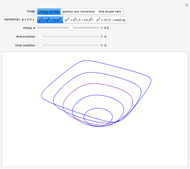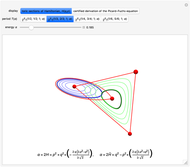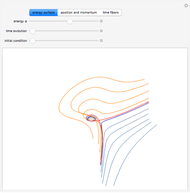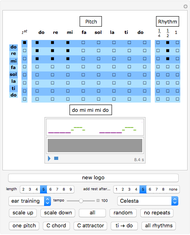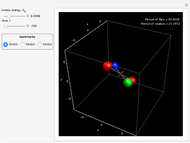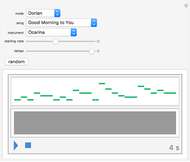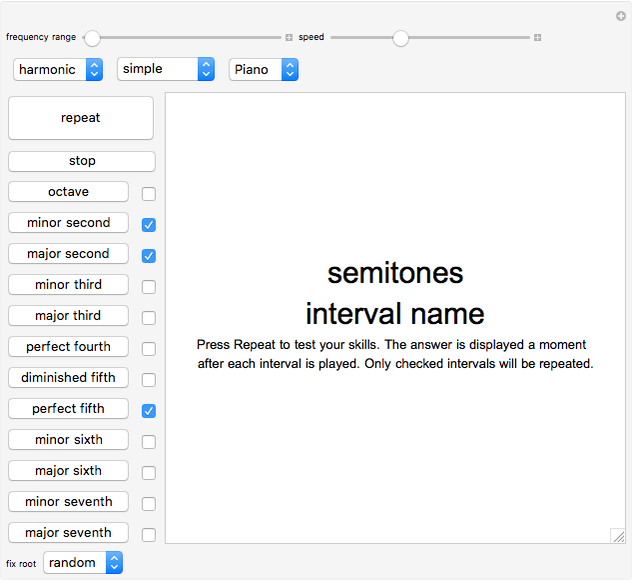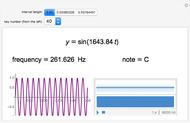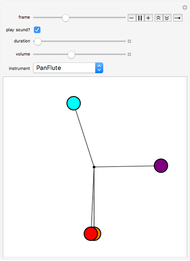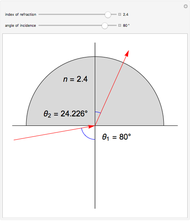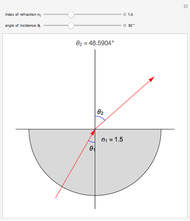Musical Animated Large-Angle Pendulums

Requires a Wolfram Notebook System
Interact on desktop, mobile and cloud with the free Wolfram Player or other Wolfram Language products.
The period of a pendulum depends on its amplitude in a complicated way. Here are four pendulums whose amplitudes are chosen so that their periods are commensurate. Plus, they're musical! Each pendulum plays a note when it passes through its lowest point. The musical frequencies are proportional to the pendulums' frequencies, so they play a happy tune. You can change which instrument they play.
Contributed by: Michael Malak (April 2014)
Open content licensed under CC BY-NC-SA
Snapshots
Details
The Wolfram Functions page Jacobi elliptic function dn: Theorems gives an exact analytic solution for the position  and
and  of a pendulum, assuming that the clock starts when the pendulum is at its lowest point. Here
of a pendulum, assuming that the clock starts when the pendulum is at its lowest point. Here  is the angular amplitude,
is the angular amplitude,  is the length of the simple pendulum, and
is the length of the simple pendulum, and  is the acceleration due to gravity.
is the acceleration due to gravity.
 ,
,
 .
.
To make the pendulum animation loop properly, we need to know how the period of a pendulum depends on its amplitude, so we can choose proper amplitudes. Now, a small-angle pendulum is approximately a harmonic oscillator, and its period is  , which does not depend on the angular amplitude. But for a large-angle pendulum, we have to figure out just how the period does depend on the amplitude. If we knew the angular velocity
, which does not depend on the angular amplitude. But for a large-angle pendulum, we have to figure out just how the period does depend on the amplitude. If we knew the angular velocity  as a function of the angle
as a function of the angle  , then we could integrate
, then we could integrate  for one complete oscillation. Or even better, integrate it for 1/4 of an oscillation, that is, from
for one complete oscillation. Or even better, integrate it for 1/4 of an oscillation, that is, from  down to 0; then we do not have to worry about the changing signs for
down to 0; then we do not have to worry about the changing signs for  and
and  . We can figure out
. We can figure out  by using conservation of mechanical energy. (Actually, we use mechanical energy per unit mass to remove the mass from consideration.)
by using conservation of mechanical energy. (Actually, we use mechanical energy per unit mass to remove the mass from consideration.)
The potential energy is  , so the potential energy per unit mass is
, so the potential energy per unit mass is  . For convenience, we measure the height from the pivot point, not the lowest point (it does not matter). This means that the height
. For convenience, we measure the height from the pivot point, not the lowest point (it does not matter). This means that the height  , so
, so  .
.
The total mechanical energy  is constant in this system. The pendulum has zero kinetic energy when it is at its highest point, that is, when
is constant in this system. The pendulum has zero kinetic energy when it is at its highest point, that is, when  . So
. So  only depends on the amplitude. Working per unit mass,
only depends on the amplitude. Working per unit mass,  .
.
The kinetic energy is then  , so
, so  .
.
The formula for kinetic energy is  , so that
, so that  , and
, and  . Notice that we only get the magnitude here.
. Notice that we only get the magnitude here.
And  . Again, this is only the magnitude.
. Again, this is only the magnitude.
 .
.
Now we are ready to integrate. We look at only 1/4 of a complete oscillation, starting from rest when  , and ending when
, and ending when  . During this part of the motion,
. During this part of the motion,  is negative because
is negative because  is decreasing.
is decreasing.
 .
.
We would particularly like to know the ratio of the period to the period of the small-angle pendulum:
 .
.
where  is the elliptic integral of the first kind (Wolfram MathWorld) (Mathematica's EllipticF). Here is another formula for the ratio that uses the complete elliptic integral of the first kind (Wolfram MathWorld) (Mathematica's EllipticK) instead. They are the same, except that
is the elliptic integral of the first kind (Wolfram MathWorld) (Mathematica's EllipticF). Here is another formula for the ratio that uses the complete elliptic integral of the first kind (Wolfram MathWorld) (Mathematica's EllipticK) instead. They are the same, except that  , which is the behavior we want, instead of
, which is the behavior we want, instead of  :
:
 .
.
The amplitudes in the Demonstration are chosen so that their  's are in the ratios (1, 5/4, 5/3, 5/2); this means that they will complete 5, 4, 3, and 2 oscillations in one complete cycle.
's are in the ratios (1, 5/4, 5/3, 5/2); this means that they will complete 5, 4, 3, and 2 oscillations in one complete cycle.
Permanent Citation






